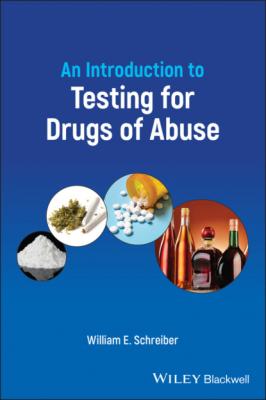An Introduction to Testing for Drugs of Abuse. William E. Schreiber
Читать онлайн.| Название | An Introduction to Testing for Drugs of Abuse |
|---|---|
| Автор произведения | William E. Schreiber |
| Жанр | Химия |
| Серия | |
| Издательство | Химия |
| Год выпуска | 0 |
| isbn | 9781119794073 |
Table 1.2 Cut‐off concentrations for drugs and metabolites in urine.
Source: United States Department of Transportation www.transportation.gov/odapc/part40/40‐87
| Analyte | Initial test | Confirmatory test |
|---|---|---|
| Marijuana metabolite (THC‐COOH) | 50 | 15 |
| Cocaine metabolite (benzoylecgonine) | 150 | 100 |
| Codeine/morphine | 2000 | 2000 |
| Hydrocodone/hydromorphone | 300 | 100 |
| Oxycodone/oxymorphone | 100 | 100 |
| 6‐Acetylmorphine | 10 | 10 |
| Phencyclidine | 25 | 25 |
| Amphetamine/methamphetamine | 500 | 250 |
| MDMA/MDA | 500 | 250 |
These cut‐offs specify the minimum concentration of a drug or metabolite that constitutes a positive test. All concentrations are in ng/mL. Samples with a positive initial test must undergo a confirmatory test before reporting the result. Grouped analytes such as codeine/morphine are both detected in the initial test, but they are measured and reported separately in the confirmatory test.
3,4‐methylenedioxyamphetamine; MDMA, 3,4‐methylenedioxymethamphetamine; THC‐COOH, delta‐9‐tetrahydrocannabinol‐9‐carboxylic acid.
What You Will Find in This Book
This book was written for students and practitioners who want a concise description of drugs of abuse and how clinical laboratories test for them. The emphasis is on interpretation of test results rather than analytical methods. The first section covers basic concepts of drug metabolism, specimen collection, and techniques for detecting and measuring drugs. The following section contains chapters on individual drugs or drug groups, all organized under similar headings. Practical information about laboratory tests (i.e., screening cut‐offs, length of time a drug can be detected, interferences) is included. Lists of metabolites that indicate use of a particular drug are provided in Appendix A.
Resources appear at the end of each chapter – they include journal articles, book chapters, government agency reports, websites, and videos. Wherever possible, website addresses are provided to give the reader quick access.
A number of case studies are attached to each chapter on individual drugs and drug groups. They are meant to pose real‐world situations in which the facts and principles discussed in this book can be applied. Cases are drawn from most of the areas mentioned above – emergency medicine, addiction medicine, pain management, workplace testing, and forensics.
General references
Drugs of abuse testing sits at the crossroads of analytical chemistry, pharmacology, toxicology, and several branches of medical practice. When searching for information about a particular drug or topic, you may need to consult a variety of sources. The following general references are recommended as a starting point.
Textbooks
1 Katzung, B.G., Masters, S.B., and Trevor, A.J. (eds.) (2012). Basic and Clinical Pharmacology, 12e. New York: McGraw‐Hill.
A classic in the field. Chapters are well organized, well written, and well illustrated. This text is worth reading to learn the basics or fill in knowledge gaps.
1 Baselt, R.C. (2011). Disposition of Toxic Drugs and Chemicals in Man, 9e. Seal Beach, CA: Biomedical Publications.
This book presents curated information on more than 1000 drugs and chemicals. Each entry contains sections on occurrence and usage, blood concentrations, metabolism and excretion, toxicity, and analysis. It is an essential reference for toxicology laboratories.
1 Hoffman, R.S., Howland, M.A., Lewin, N.A. et al. (eds.) (2015). Goldfrank's Toxicologic Emergencies, 10e. New York: McGraw‐Hill.
Another classic, Goldfrank's is the reigning bible of toxicology in the emergency setting. Historical background, pharmacology, pathophysiology, clinical presentation, diagnosis, and management are covered for most drugs/toxins/poisons. Chapters are somewhat variable in structure and content.
Review article
1 Schulz, M., Schmoldt, A., Andresen‐Streichert, H., and Iwersen‐Bergmann, S. (2020). Revisited: Therapeutic and toxic blood concentrations of more than 1100 drugs and other xenobiotics. Crit. Care 24: 195.
The authors have compiled a list of therapeutic, toxic, and fatal blood concentrations for 1100+ drugs – the list of annotations and references is even longer. These tables are especially useful when reviewing postmortem toxicology results, as they can assist in determining the cause of death.
Websites
National Institute on Drug Abuse (NIDA) www.drugabuse.gov
The National Institute on Drug Abuse is one of the institutes of the National Institutes of Health. Its mission is “… to advance science on the causes and consequences of drug use and addiction and to apply that knowledge to improve individual and public health.” The NIDA website contains extensive information on drugs of abuse written in easily understood language.
Substance Abuse and Mental Health Services Administration (SAMHSA)www.samhsa.gov
The Substance Abuse and Mental Health Services Administration is an agency within the US Department of Health and Human Services. Its mission is “… to reduce the impact of substance abuse and mental illness on America's communities.” The SAMHSA website offers numerous publications, brochures, and fact sheets related to substance abuse.
Centre for Addiction and Mental Health (CAMH) www.camh.ca
The Centre for Addiction and Mental Health is “… Canada's largest mental health teaching hospital and one of the world's leading research centers in its field.” The Health Info tab on the CAMH website has educational material on drug use, addiction, and
